-
 Bitcoin
Bitcoin $87,066.3384
2.57% -
 Ethereum
Ethereum $1,575.4052
-0.49% -
 Tether USDt
Tether USDt $1.0000
0.00% -
 XRP
XRP $2.0743
-0.02% -
 BNB
BNB $595.7825
0.83% -
 Solana
Solana $136.4079
-0.38% -
 USDC
USDC $0.9999
-0.01% -
 Dogecoin
Dogecoin $0.1581
2.00% -
 TRON
TRON $0.2461
0.07% -
 Cardano
Cardano $0.6196
0.16% -
 Chainlink
Chainlink $13.0591
-2.01% -
 UNUS SED LEO
UNUS SED LEO $9.1392
-2.02% -
 Avalanche
Avalanche $19.8657
2.37% -
 Stellar
Stellar $0.2514
3.00% -
 Toncoin
Toncoin $2.8936
-3.40% -
 Shiba Inu
Shiba Inu $0.0...01231
-0.36% -
 Sui
Sui $2.1999
4.48% -
 Hedera
Hedera $0.1692
2.08% -
 Bitcoin Cash
Bitcoin Cash $343.9033
2.31% -
 Hyperliquid
Hyperliquid $18.0140
3.65% -
 Polkadot
Polkadot $3.7968
-2.33% -
 Litecoin
Litecoin $77.6904
0.03% -
 Dai
Dai $0.9999
0.00% -
 Bitget Token
Bitget Token $4.4339
0.86% -
 Ethena USDe
Ethena USDe $0.9993
-0.01% -
 Pi
Pi $0.6352
-0.68% -
 Monero
Monero $215.3155
0.42% -
 Uniswap
Uniswap $5.2608
0.42% -
 Pepe
Pepe $0.0...07751
3.06% -
 Aptos
Aptos $4.9488
-1.93%
How to calculate Bitcoin contract margin?
Bitcoin contract margin, the collateral securing leveraged positions, is calculated using contract size, Bitcoin price, and leverage. Higher leverage amplifies profits but drastically increases risk, potentially leading to margin calls and liquidation if equity falls below maintenance margin.
Mar 15, 2025 at 01:55 pm
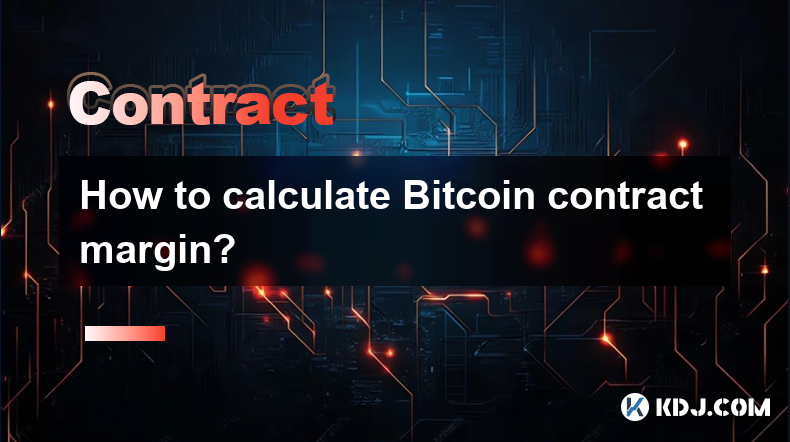
How to Calculate Bitcoin Contract Margin: A Deep Dive into Leverage and Risk Management in Crypto Futures Trading
Key Points:
- Understanding Margin: Margin is the collateral you deposit to open and maintain a leveraged position in a Bitcoin contract. It acts as a guarantee for the exchange against potential losses. The amount required depends on the leverage used, the contract size, and the margin requirements set by the exchange.
- Leverage and its Impact: Leverage amplifies both profits and losses. Higher leverage means a smaller margin is needed to control a larger position, but also signifies greater risk. Understanding the leverage multiplier is crucial for calculating margin.
- Margin Types: Different exchanges offer various margin types, including initial margin, maintenance margin, and margin call. Knowing the distinction between these is vital for avoiding liquidation.
- Calculating Initial Margin: The initial margin is the amount needed to open a position. This calculation involves the contract size, the leverage, and the current Bitcoin price.
- Calculating Maintenance Margin: The maintenance margin is the minimum amount of equity required to keep a position open. Falling below this level triggers a margin call. This calculation is similar to initial margin but uses a lower percentage.
- Margin Call and Liquidation: A margin call occurs when your equity falls below the maintenance margin. You must deposit more funds to meet the margin requirement. Failure to do so leads to liquidation, where the exchange closes your position to cover losses.
- Understanding Margin in Bitcoin Contract Trading:
Margin in the context of Bitcoin contracts is the collateral you provide to the exchange to secure a leveraged position. Unlike spot trading where you buy and hold Bitcoin directly, futures contracts allow you to speculate on the future price of Bitcoin without owning the underlying asset. This speculation is amplified by leverage, a multiplier that allows you to control a larger position than your actual capital would permit. For example, 10x leverage means you can control a position worth ten times your margin. However, this amplification also applies to losses, meaning a small price movement against your position can quickly wipe out your entire margin. The exchange requires margin to protect itself from potential losses if the market moves against you. The margin acts as a guarantee, ensuring that the exchange can recover its losses if your position goes into the red. Understanding how margin is calculated is therefore fundamental to responsible Bitcoin contract trading. This calculation involves several factors, including the contract size, leverage, and the current Bitcoin price. Ignoring these calculations can lead to significant financial losses, even liquidation, where the exchange closes your position to cover its exposure. Different exchanges may have slightly varying methodologies, but the core principles remain the same. Always refer to the specific guidelines of your chosen exchange. Effective risk management involves carefully considering the level of leverage employed, regularly monitoring your margin levels, and having a clear exit strategy.
- The Role of Leverage in Bitcoin Contract Margin Calculations:
Leverage is a double-edged sword in Bitcoin contract trading. It significantly amplifies both potential profits and losses. A higher leverage multiplier allows you to control a larger position with a smaller amount of capital. For instance, with 10x leverage, a $1000 margin can control a $10,000 position. This magnifies potential returns, allowing for substantial profits from relatively small price movements. However, this same amplification applies to losses. A small adverse price movement can quickly erode your margin, leading to a margin call and potentially liquidation. Calculating the required margin with leverage is crucial. The formula typically involves dividing the contract value (contract size multiplied by the Bitcoin price) by the leverage multiplier. For example, if the contract size is 1 BTC, the Bitcoin price is $30,000, and you're using 5x leverage, the initial margin requirement would be ($30,000 / 5) = $6,000. This means you need to deposit $6,000 to open this position. It's crucial to understand that the higher the leverage, the lower the margin requirement, but also the higher the risk. A poorly managed leveraged position can quickly lead to significant losses and even total liquidation of your funds. Therefore, choosing the appropriate leverage level based on your risk tolerance and trading experience is essential. Many experienced traders prefer lower leverage to mitigate risk, while others might utilize higher leverage to maximize potential profits, acknowledging the increased risk involved. Irrespective of your choice, a thorough understanding of leverage and its impact on margin calculations is non-negotiable.
- Different Types of Margin in Bitcoin Contract Trading:
Several types of margin are crucial to understand in the context of Bitcoin contract trading. The first is the initial margin, which is the amount you need to deposit to open a position. This is calculated based on the contract size, leverage, and the current Bitcoin price. The second is the maintenance margin, which is the minimum amount of equity you must maintain in your account to keep your position open. This is usually a lower percentage than the initial margin. If your account equity falls below the maintenance margin, you receive a margin call, a warning that you need to deposit more funds to bring your equity back above the maintenance margin level. Failure to meet a margin call within the specified timeframe results in liquidation, where the exchange automatically closes your position to limit its exposure to potential losses. The liquidation price is usually set below the maintenance margin level, ensuring the exchange recoups its losses. Understanding these different margin types is crucial for effective risk management. Traders should monitor their account equity closely and be prepared to deposit additional funds if a margin call is issued. Ignoring a margin call can lead to a forced liquidation, resulting in significant losses. The exact percentages for initial and maintenance margins vary across different exchanges and even for different trading pairs on the same exchange. It is essential to review the specific margin requirements for each contract before entering a trade. Understanding these nuances is paramount to successfully navigating the complexities of leveraged Bitcoin contract trading. Furthermore, some exchanges offer different margin modes, such as cross margin and isolated margin, which further affect the calculation and management of your margin. Understanding these subtleties is crucial for advanced trading strategies.
- Calculating Initial Margin for Bitcoin Contracts:
Calculating the initial margin required to open a Bitcoin contract involves several factors. Firstly, you need to know the contract size. This represents the amount of Bitcoin controlled by one contract. It’s often expressed in BTC (e.g., 1 BTC, 0.1 BTC). Secondly, you need the current market price of Bitcoin. This price is usually taken from the exchange's order book. Thirdly, the leverage you intend to use is crucial. Leverage amplifies both your potential profits and losses. The formula for calculating initial margin is generally: (Contract Size * Bitcoin Price) / Leverage. For instance, if you want to open a contract for 1 BTC, the Bitcoin price is $30,000, and you're using 10x leverage, the initial margin calculation would be: (1 BTC * $30,000) / 10 = $3,000. This means you would need to deposit $3,000 to open this position. However, this is a simplified example. Different exchanges might add additional fees or adjustments to this calculation. Always refer to your exchange's specific margin requirements. Factors like fees, slippage, and potential price fluctuations can impact your margin calculations. Furthermore, exchanges might use different methods for calculating margin, so it's vital to understand your exchange's specific methodology. Some exchanges use a mark-to-market pricing system, meaning your margin requirement is adjusted based on real-time price changes. Understanding these nuances is crucial for accurate margin calculations and effective risk management. Failure to correctly calculate your initial margin can lead to unexpected margin calls and potential liquidation.
- Calculating Maintenance Margin and Understanding Margin Calls:
Maintenance margin is the minimum amount of equity you need to maintain in your trading account to keep your leveraged position open. It's typically expressed as a percentage of the initial margin or the notional value of your position. This percentage is lower than the initial margin percentage, providing a buffer before a margin call is triggered. For example, if your initial margin is $3,000 and the maintenance margin requirement is 50%, your maintenance margin would be $1,500. If your account equity falls below this level, you receive a margin call. The calculation is similar to initial margin but uses the maintenance margin percentage instead of 100%. A margin call is a warning that your position is at risk of liquidation. It's a signal to either deposit more funds to increase your equity above the maintenance margin level or to close part or all of your position to reduce your risk exposure. The timeframe given to respond to a margin call varies across exchanges, but it’s usually relatively short. Failure to respond within the specified timeframe leads to liquidation, where the exchange closes your position automatically to minimize its losses. The liquidation price is typically set slightly below the maintenance margin level to ensure the exchange recovers its exposure. Understanding maintenance margin and responding promptly to margin calls are crucial for avoiding liquidation and mitigating losses in leveraged Bitcoin contract trading. Closely monitoring your account equity and understanding your exchange's margin call procedures are vital aspects of risk management.
- Margin Call, Liquidation, and Risk Management Strategies:
A margin call signifies that your account equity has fallen below the maintenance margin level. This means that the value of your position has decreased, and your margin is insufficient to cover potential losses. At this point, you need to take action quickly. You have two main options: deposit additional funds to increase your account equity above the maintenance margin level, or close part or all of your position to reduce your risk exposure. The exchange usually provides a grace period to respond to a margin call. However, if you fail to take action within this period, the exchange will proceed with liquidation. Liquidation is the automatic closing of your position by the exchange to cover its losses. This process usually occurs at a price slightly below the market price, resulting in a loss for you. The liquidation price is often set to ensure the exchange recovers its exposure. Effective risk management involves avoiding margin calls and liquidations altogether. This requires careful consideration of leverage, position sizing, and stop-loss orders. Using lower leverage reduces the likelihood of margin calls. Proper position sizing ensures that your position size is appropriate for your account balance and risk tolerance. Stop-loss orders automatically close your position if the price moves against you, preventing significant losses. Furthermore, diversifying your portfolio across multiple assets and utilizing other risk management techniques can further minimize the risk of margin calls and liquidations. Understanding these concepts and implementing effective risk management strategies are crucial for long-term success in leveraged Bitcoin contract trading.
FAQs:
Q: What is the difference between initial margin and maintenance margin?
A: Initial margin is the amount required to open a position, while maintenance margin is the minimum equity needed to keep it open. Falling below the maintenance margin triggers a margin call.
Q: What happens if I don't meet a margin call?
A: If you fail to deposit enough funds to meet a margin call within the given timeframe, the exchange will liquidate your position to cover its losses.
Q: How does leverage affect my margin requirements?
A: Higher leverage means a smaller margin is needed to control a larger position, but it also significantly increases your risk.
Q: Can I choose my leverage level?
A: Yes, most exchanges allow you to select your leverage level within a defined range. However, higher leverage comes with substantially increased risk.
Q: What is liquidation price?
A: The liquidation price is the price at which the exchange automatically closes your position during a margin call if you fail to meet the requirements. It's usually slightly below the current market price to ensure the exchange recovers its losses.
Q: How can I minimize the risk of liquidation?
A: Employ effective risk management techniques including using lower leverage, implementing stop-loss orders, carefully sizing positions relative to your account balance, and diversifying your portfolio. Regularly monitor your account equity and understand your exchange's margin requirements.
Q: Where can I find the specific margin requirements for my exchange?
A: Each exchange publishes its margin requirements for different trading pairs and contract types. Look for this information in their help section or trading platform's settings. It's crucial to understand these details before initiating any trades.
Q: Are there different types of margin accounts?
A: Yes, some exchanges offer different margin modes such as isolated margin and cross margin. Isolated margin protects your other assets from losses on a specific trade, while cross margin uses your overall account balance as collateral. The implications for margin calculations and risk are significantly different between these modes.
This detailed explanation provides a comprehensive understanding of Bitcoin contract margin calculations, but remember that specific details might vary slightly across different cryptocurrency exchanges. Always consult the official documentation of your chosen platform for precise information and to ensure you understand their specific terms and conditions. The information provided here should not be considered financial advice.
Disclaimer:info@kdj.com
The information provided is not trading advice. kdj.com does not assume any responsibility for any investments made based on the information provided in this article. Cryptocurrencies are highly volatile and it is highly recommended that you invest with caution after thorough research!
If you believe that the content used on this website infringes your copyright, please contact us immediately (info@kdj.com) and we will delete it promptly.
- Coinbase Lists Reserve Rights (RSR), a Dual-Token Stablecoin Platform Aimed at Creating a Collateral-Backed, Self-Regulating Stablecoin Ecosystem
- 2025-04-22 06:40:13
- The Ultimate Guide to Capital Rotation in the Cryptocurrency Market
- 2025-04-22 06:40:13
- Mantra's CEO Keeps His Word – Massive Tokens Burned: Will $OM Price Go From Collapse to Catalyst?
- 2025-04-22 06:35:14
- TRUMP Token Price Soars After Unlocking 40M New Coins
- 2025-04-22 06:35:14
- Avalanche Foundation Launches the Avalanche Card, Allowing Holders to Access Their Crypto Assets Seamlessly Around the World
- 2025-04-22 06:30:12
- The OM Token Crash: A Stark Reminder of Crypto's Wild West Nature
- 2025-04-22 06:30:12
Related knowledge
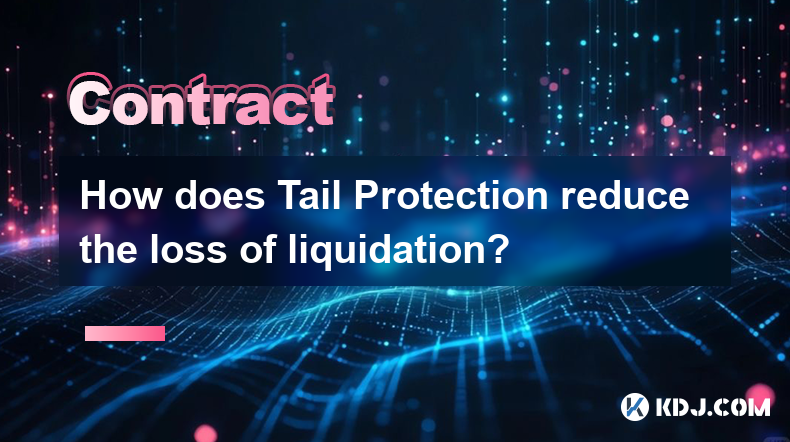
How does Tail Protection reduce the loss of liquidation?
Apr 11,2025 at 01:50am
Introduction to Tail Protection in CryptocurrencyTail Protection is a mechanism designed to mitigate the risks associated with liquidation in cryptocurrency trading. Liquidation occurs when a trader's position is forcibly closed by the exchange due to insufficient margin to cover potential losses. This often happens in leveraged trading, where traders b...
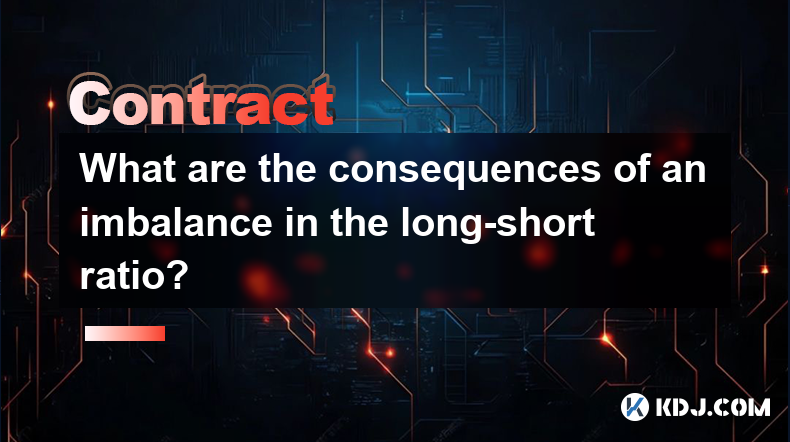
What are the consequences of an imbalance in the long-short ratio?
Apr 13,2025 at 02:50pm
The long-short ratio is a critical metric in the cryptocurrency trading world, reflecting the balance between bullish and bearish sentiments among traders. An imbalance in this ratio can have significant consequences on the market dynamics, affecting everything from price volatility to trading strategies. Understanding these consequences is essential fo...

How to judge the market trend by the position volume?
Apr 11,2025 at 02:29pm
Understanding how to judge the market trend by position volume is crucial for any cryptocurrency trader. Position volume, which refers to the total number of open positions in a particular cryptocurrency, can provide valuable insights into market sentiment and potential price movements. By analyzing this data, traders can make more informed decisions ab...

Why does a perpetual contract have no expiration date?
Apr 09,2025 at 08:43pm
Perpetual contracts, also known as perpetual futures or perpetual swaps, are a type of derivative product that has gained significant popularity in the cryptocurrency market. Unlike traditional futures contracts, which have a fixed expiration date, perpetual contracts do not expire. This unique feature raises the question: why does a perpetual contract ...
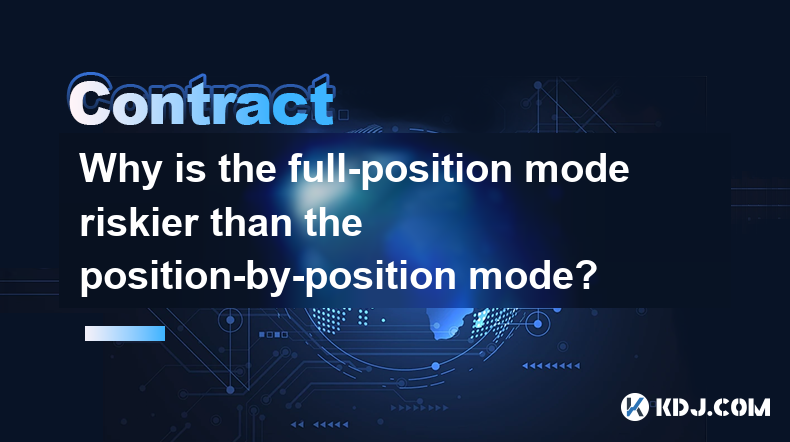
Why is the full-position mode riskier than the position-by-position mode?
Apr 13,2025 at 03:42pm
Why is the Full-Position Mode Riskier Than the Position-by-Position Mode? In the world of cryptocurrency trading, the choice between full-position mode and position-by-position mode can significantly impact the risk profile of a trader's portfolio. Understanding the differences between these two modes is crucial for making informed trading decisions. Th...
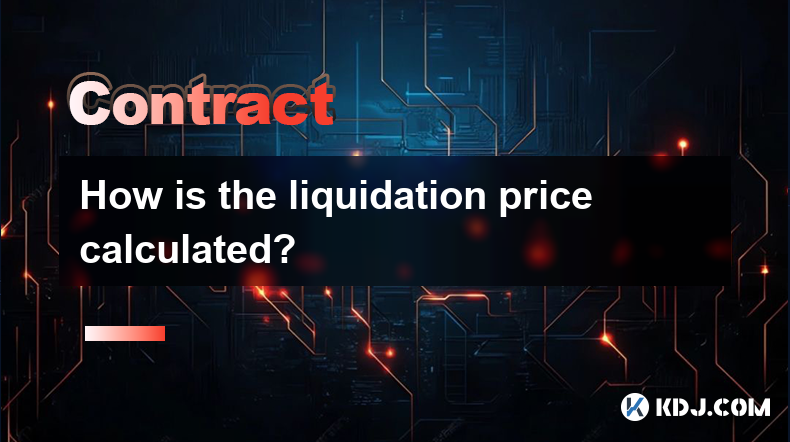
How is the liquidation price calculated?
Apr 12,2025 at 01:35am
Introduction to Liquidation PriceLiquidation price is a critical concept in the world of cryptocurrency trading, particularly when dealing with leveraged positions. Understanding how this price is calculated is essential for traders to manage their risk effectively. The liquidation price is the point at which a trader's position is forcibly closed by th...

How does Tail Protection reduce the loss of liquidation?
Apr 11,2025 at 01:50am
Introduction to Tail Protection in CryptocurrencyTail Protection is a mechanism designed to mitigate the risks associated with liquidation in cryptocurrency trading. Liquidation occurs when a trader's position is forcibly closed by the exchange due to insufficient margin to cover potential losses. This often happens in leveraged trading, where traders b...

What are the consequences of an imbalance in the long-short ratio?
Apr 13,2025 at 02:50pm
The long-short ratio is a critical metric in the cryptocurrency trading world, reflecting the balance between bullish and bearish sentiments among traders. An imbalance in this ratio can have significant consequences on the market dynamics, affecting everything from price volatility to trading strategies. Understanding these consequences is essential fo...

How to judge the market trend by the position volume?
Apr 11,2025 at 02:29pm
Understanding how to judge the market trend by position volume is crucial for any cryptocurrency trader. Position volume, which refers to the total number of open positions in a particular cryptocurrency, can provide valuable insights into market sentiment and potential price movements. By analyzing this data, traders can make more informed decisions ab...

Why does a perpetual contract have no expiration date?
Apr 09,2025 at 08:43pm
Perpetual contracts, also known as perpetual futures or perpetual swaps, are a type of derivative product that has gained significant popularity in the cryptocurrency market. Unlike traditional futures contracts, which have a fixed expiration date, perpetual contracts do not expire. This unique feature raises the question: why does a perpetual contract ...

Why is the full-position mode riskier than the position-by-position mode?
Apr 13,2025 at 03:42pm
Why is the Full-Position Mode Riskier Than the Position-by-Position Mode? In the world of cryptocurrency trading, the choice between full-position mode and position-by-position mode can significantly impact the risk profile of a trader's portfolio. Understanding the differences between these two modes is crucial for making informed trading decisions. Th...

How is the liquidation price calculated?
Apr 12,2025 at 01:35am
Introduction to Liquidation PriceLiquidation price is a critical concept in the world of cryptocurrency trading, particularly when dealing with leveraged positions. Understanding how this price is calculated is essential for traders to manage their risk effectively. The liquidation price is the point at which a trader's position is forcibly closed by th...
See all articles






















































































